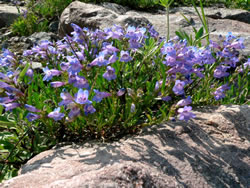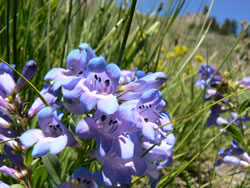Plant of the Week
 Range map of Penstemon leonardii var. leonardii. States are colored green where the species may be found.
Range map of Penstemon leonardii var. leonardii. States are colored green where the species may be found.
 Leonard's Penstemon (Penstemon leonardii var. leonardii). Photo by Teresa Prendusi.
Leonard's Penstemon (Penstemon leonardii var. leonardii). Photo by Teresa Prendusi.
 Penstemon leonardii var. leonardii and bumblebee pollinator. Photo by Teresa Prendusi.
Penstemon leonardii var. leonardii and bumblebee pollinator. Photo by Teresa Prendusi.
 Penstemon leonardii var leonardii horseshoe anthers. Photo by Teresa Prendusi.
Penstemon leonardii var leonardii horseshoe anthers. Photo by Teresa Prendusi.
Leonard's Penstemon (Penstemon leonardii var. leonardii)
By Teresa Prendusi
Commonly known as the beardtongue(s), the genus Penstemon with over 280 species, is found only in North America. The genus was formerly placed in the Scrophulariaceae family but recent genetic studies have aligned it within the Plantaginaceae family. Penstemons range in size from over six feet tall to less than an inch and are found in a large variety of colors, from electric blue to firecracker red, to various shades pinks, white, maroon, and lavender. The Great Basin of the intermountain West is particularly rich in Penstemon diversity and endemism, with Nevada and Utah being premier areas to view an exceptional number of different species from low desert canyons to high alpine communities.
One of the more stunning endemics, Leonard's penstemon, is found along the northern Wasatch mountain range of Utah and Bear River Range of southeastern Idaho. It is a compact, one-foot tall multi-stemmed sub-shrub with many medium size deep-blue to violet colored flowers arranged in 3-6 verticillasters (arising in the axils of opposite leaves) along the flowering stem. The bilabiate flowers are 14-26 millimeters long, glabrous, with the lower 3-lobed lip projecting slightly beyond the upper. The fertile stamens reach the flower orifice but are not exerted beyond it. The anthers are horseshoe shaped and dehisce along the suture across their confluent area of attachment.
Leonard's penstemon often grows with several other closely related Penstemon species (P. platyphyllus and P. sepalulus), but does not hybridize with them. It is thought that these species may have evolved allopatrically (i.e. separated geographically) and migrated to their present sites following climatic changes.
Penstemon leonardii var. leonardii blooms from mid-May to late July and is pollinated by native bees. It grows at elevations ranging from 6,000-10,000 feet in rocky openings in oak-maple-serviceberry communities and up to the higher elevation conifer-aspen and lodgepole pine areas.

